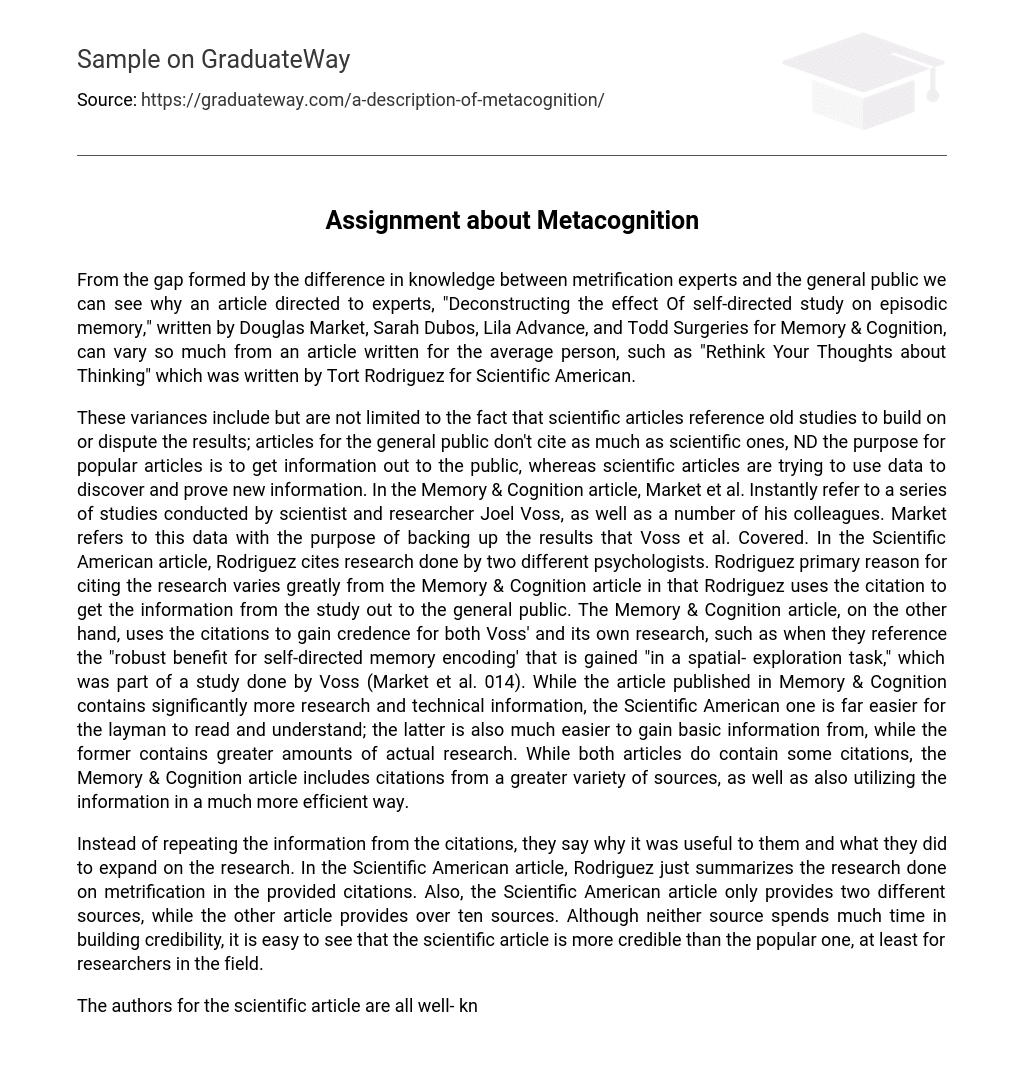From the gap formed by the difference in knowledge between metrification experts and the general public we can see why an article directed to experts, “Deconstructing the effect Of self-directed study on episodic memory,” written by Douglas Market, Sarah Dubos, Lila Advance, and Todd Surgeries for Memory & Cognition, can vary so much from an article written for the average person, such as “Rethink Your Thoughts about Thinking” which was written by Tort Rodriguez for Scientific American.
These variances include but are not limited to the fact that scientific articles reference old studies to build on or dispute the results; articles for the general public don’t cite as much as scientific ones, ND the purpose for popular articles is to get information out to the public, whereas scientific articles are trying to use data to discover and prove new information. In the Memory & Cognition article, Market et al. Instantly refer to a series of studies conducted by scientist and researcher Joel Voss, as well as a number of his colleagues. Market refers to this data with the purpose of backing up the results that Voss et al. Covered. In the Scientific American article, Rodriguez cites research done by two different psychologists. Rodriguez primary reason for citing the research varies greatly from the Memory & Cognition article in that Rodriguez uses the citation to get the information from the study out to the general public. The Memory & Cognition article, on the other hand, uses the citations to gain credence for both Voss’ and its own research, such as when they reference the “robust benefit for self-directed memory encoding’ that is gained “in a spatial- exploration task,” which was part of a study done by Voss (Market et al. 014). While the article published in Memory & Cognition contains significantly more research and technical information, the Scientific American one is far easier for the layman to read and understand; the latter is also much easier to gain basic information from, while the former contains greater amounts of actual research. While both articles do contain some citations, the Memory & Cognition article includes citations from a greater variety of sources, as well as also utilizing the information in a much more efficient way.
Instead of repeating the information from the citations, they say why it was useful to them and what they did to expand on the research. In the Scientific American article, Rodriguez just summarizes the research done on metrification in the provided citations. Also, the Scientific American article only provides two different sources, while the other article provides over ten sources. Although neither source spends much time in building credibility, it is easy to see that the scientific article is more credible than the popular one, at least for researchers in the field.
The authors for the scientific article are all well- known researchers in their respective fields, and let their peer-reviewed study ND their credentials speak for themselves, such as how Murrain is a postdoctoral fellow at the Center for Adaptive Rationality, Outdoor is a PhD student at New York University, and Surgeries and Advance are professors at NYU. Meanwhile the Scientific American article’s author is simply one of magazine’s journalists. They aren’t equally credible as authors since Murrain et al. Are all well respected in their area of study and are more knowledgeable on the subject, while Rodriguez is simply a scientific journalist.
The inherent differences between these two articles could mostly be attributed to the extinction between the two audiences, since for the Scientific American article the author knows that they need to include more basic terminology so that the common man can understand it. There aren’t many similarities between the two articles; this can be justified by the fact that the purpose, audience, and general knowledge level of the two articles vary greatly. Although the overall topic of the two articles is similar, they are both geared toward completely different audiences and the respective purpose for writing each article is completely different.
They both accomplish what they set out to do, and while it is easy to see why the scientific article provides better information, it is also easy to see the benefit of having read the popular article. The popular article provides its readers with general information, giving non-specialists the chance to learn more about metrification on a broader scale. The scientific article, however, allows other specialists in the field the ability to review the authors’ findings in order to learn from said findings and incorporate them in the specialists’ own works.





